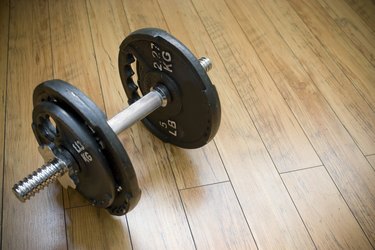
Working with dumbbells, which are free weights attached to tubular handles, is an effective way to build muscle mass and strength via resistance. Doing a dumbbell curl involves lifting the weight with your hand by bending your elbow. Dumbbell curls exercise the muscles of your arm, especially the biceps group. The two main types of dumbbell curls are called standard and hammer curls. Hammer curls may incur more thumb pain because of the different hand position, although forearm and elbow pain is much more common.
Standard Dumbbell Curl
Video of the Day
Dumbbell curls are done in either standing or sitting positions and by lifting one arm at a time or lifting both arms together. The standard curl is done with a supinated hand and forearm, which means the palms of your hands face upward. Your elbow joint should bend to an angle of about 45 degrees as you lift the dumbbell toward your upper arm. Dumbbell curls primarily exercise the biceps brachii muscle of your upper arm and the brachioradialis muscle of your lower forearm, although the tendons of your wrist get challenged as well, according to the book "Human Physiology: An Integrated Approach." Pain from lifting too much weight is usually felt around the wrist, elbow or anterior shoulder where the biceps tendon attaches to your scapula bone.
Video of the Day
Hammer Curl
The hammer curl involves the same basic lifting motion as the standard curl, but your hand is internally rotated such that your wrist is locked and your thumb points upward. As such, you grip the dumbbell much like you would a large stein of beer, for example. With the hammer curl, you get more forearm involvement and less biceps involvement because it challenges the muscles at different angles. With standard dumbbell curls, you might feel your wrists weaken during the last few repetitions, but this does not usually happen with hammer curls. Your thumb may be more vulnerable to injury, though, if the dumbbell slips in your hand and impacts your thumb.
Thumb Pain
Thumb pain is possible with both types of curls, but for different reasons. The standard curl challenges the wrist more, which can strain a tendon that moves the thumb such as the abductor pollicis longus tendon or the extensor pollicis brevis tendon. The hammer curl challenges the wrist less, but the dumbbell can slip in your hand and injure either the proximal or distal joint of the thumb. Injuries and inflammations of joints are called sprains, whereas injuries to tendons and muscles are called strains. Both sprains and strain are usually treated with rest, ice and short-term use of anti-inflammatory medications.
Helpful Suggestions
To reduce your risk of a thumb injury, use weight that allows smooth and controlled motion. Start with lesser amounts of weight and add more as you get stronger. Further, keep your wrist in a locked position and never lift a dumbbell with wet or moist hands. If your thumb pain persists for more than a week, consult with your doctor, who may recommend X-rays in order to more accurately diagnose your condition.